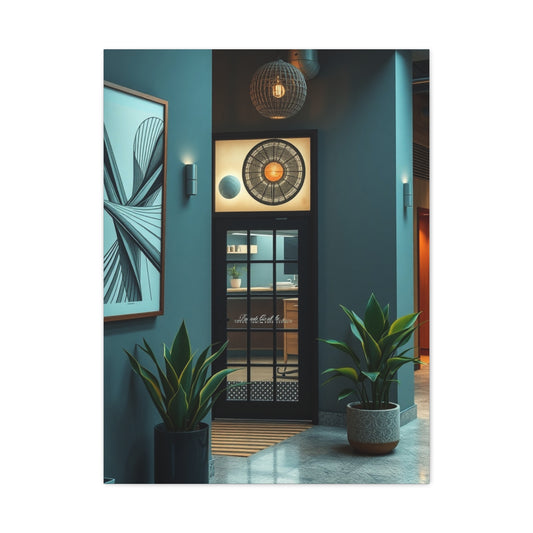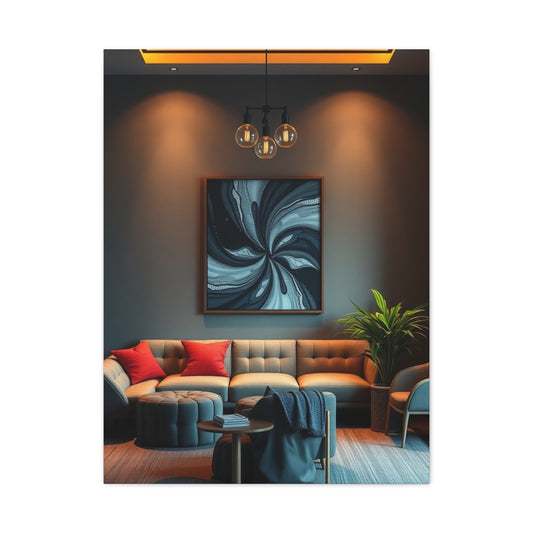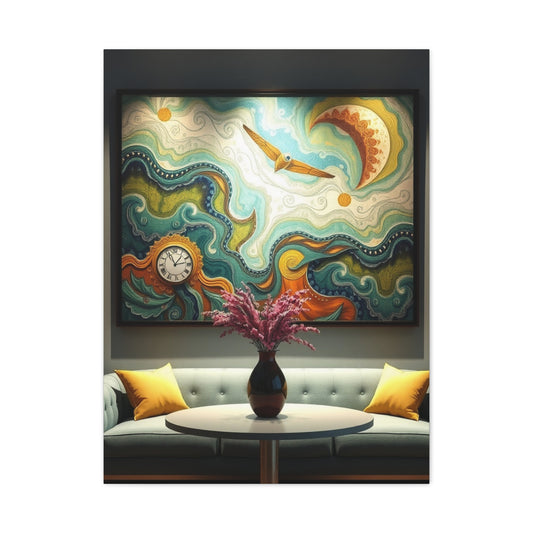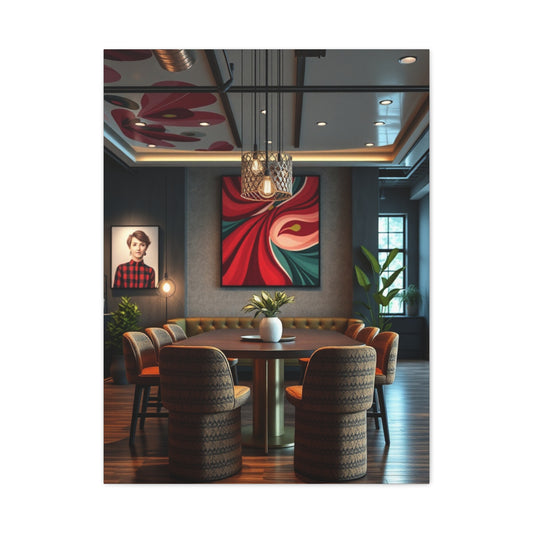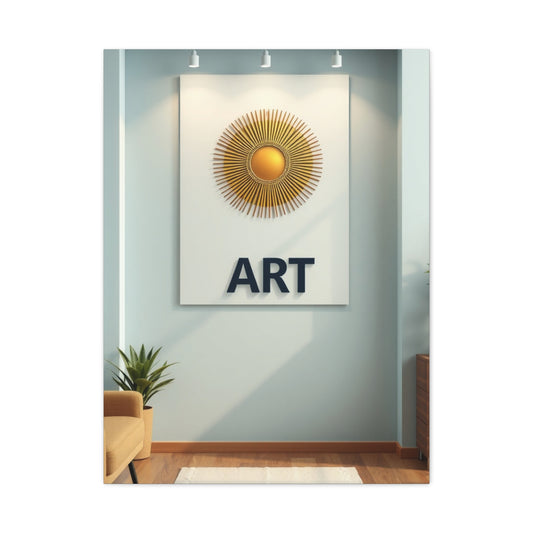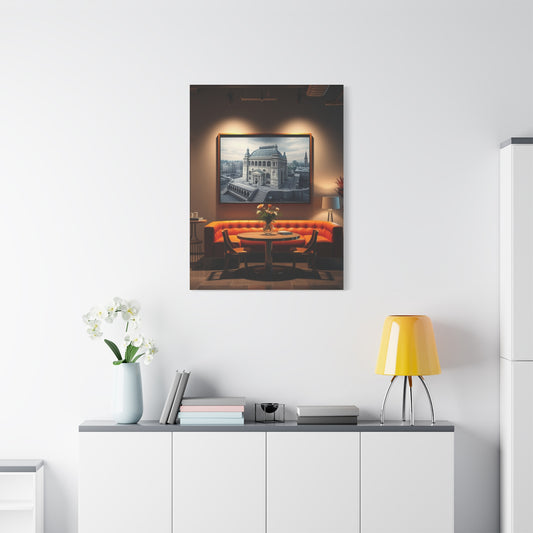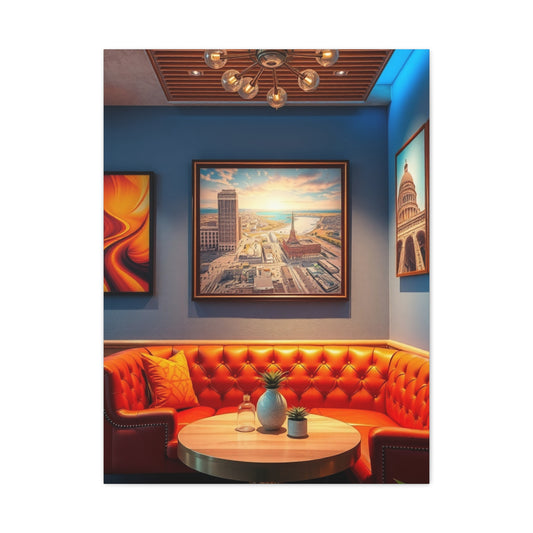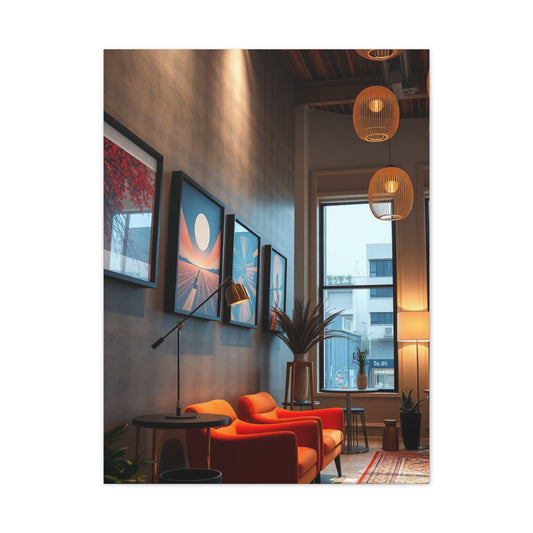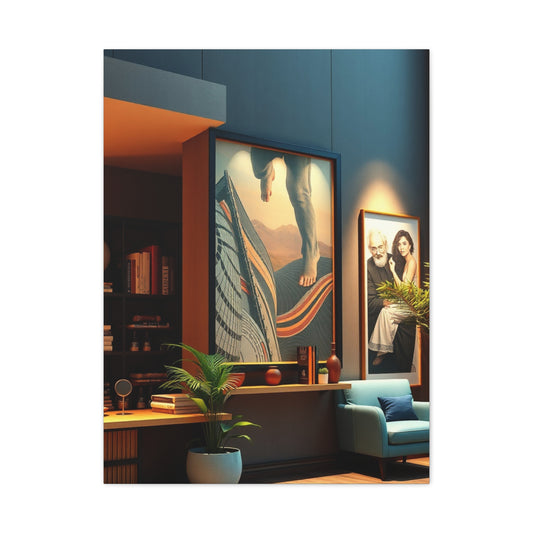The Role of Color Psychology in Commercial Wall Art and Corporate Branding
Creating an exceptional workplace environment requires understanding the profound psychological impact that visual elements exert on human behavior and productivity. Research consistently demonstrates that thoughtfully curated visual environments significantly influence employee satisfaction, client perceptions, and overall business success. The strategic implementation of wall art transcends mere decoration, serving as a powerful tool for corporate branding, employee motivation, and atmospheric enhancement.
The human brain processes visual information remarkably quickly, forming impressions within milliseconds of entering a space. These instantaneous judgments affect mood, energy levels, and cognitive performance throughout the workday. Consequently, corporate leaders increasingly recognize that investing in sophisticated wall art solutions represents a strategic business decision rather than an optional aesthetic enhancement.
Contemporary neuroscience reveals fascinating insights about how visual stimuli influence workplace dynamics. Colors trigger specific emotional responses, with blue promoting focus and creativity, green encouraging balance and tranquility, and warm earth tones fostering comfort and approachability. Abstract patterns can stimulate innovative thinking, while nature-inspired imagery reduces stress hormones and enhances mental clarity.
Moreover, the presence of visually appealing environments correlates with increased employee retention rates, improved client satisfaction scores, and enhanced brand reputation. Companies that prioritize visual excellence often experience measurable improvements in recruitment success, as potential employees associate thoughtful design with progressive corporate culture and attention to detail.
The concept of environmental psychology emphasizes how physical surroundings shape behavior and performance. Well-designed commercial spaces with carefully selected wall art can reduce absenteeism, minimize workplace stress, and encourage collaborative interactions among team members. These benefits translate directly into improved business outcomes and competitive advantages.
Understanding color theory becomes essential when selecting corporate wall art. Warm colors like reds and oranges stimulate energy and enthusiasm, making them suitable for creative departments or brainstorming areas. Cool colors such as blues and greens promote concentration and analytical thinking, ideal for accounting firms or research facilities. Neutral tones provide versatility and timeless appeal, ensuring longevity in design investments.
The scale and proportion of wall art pieces significantly impact spatial perception. Large-format artworks can make compact offices appear more spacious, while smaller grouped pieces create intimate conversation areas within expansive open-plan layouts. Strategic placement at eye level ensures maximum visual impact while maintaining ergonomic comfort for viewers.
Cultural considerations also play crucial roles in corporate wall art selection. Global businesses must navigate diverse aesthetic preferences and cultural sensitivities when choosing visual elements for multinational offices. What resonates positively in one culture might inadvertently convey unintended messages in another, making cultural awareness essential for international corporate design strategies.
Sophisticated Canvas Solutions for Modern Workplaces
Canvas artworks represent the pinnacle of versatile corporate wall art solutions, offering unlimited creative possibilities while maintaining professional sophistication. Unlike traditional framed pieces, canvas prints provide seamless integration into contemporary office environments, creating polished appearances that complement modern architectural elements.
The versatility of canvas materials allows for stunning reproductions of original artworks, custom photography, and bespoke graphic designs tailored specifically for corporate brand identities. High-quality canvas printing techniques now achieve museum-grade color accuracy and longevity, ensuring that investments in corporate wall art maintain their visual impact for decades.
Contemporary canvas printing capabilities extend far beyond simple image reproduction. Specialized printing techniques can incorporate metallic accents, textured surfaces, and dimensional effects that add tactile interest and visual depth. These enhanced canvas solutions create focal points that command attention while maintaining the subtle elegance required for professional environments.
Custom canvas commissions offer unparalleled opportunities for corporate storytelling. Companies can collaborate with artists to create unique pieces that reflect organizational history, mission statements, or future aspirations. These bespoke artworks become conversation starters, helping to establish memorable impressions on clients and visitors while reinforcing corporate identity among employees.
Multi-panel canvas installations provide dynamic visual impact through segmented storytelling. These sophisticated arrangements can transform entire wall surfaces into immersive experiences that guide viewers through carefully crafted narratives. Whether depicting company evolution, product development journeys, or inspirational themes, multi-panel canvas displays create engaging focal points that encourage contemplation and discussion.
The durability advantages of canvas prints make them particularly suitable for high-traffic commercial environments. Unlike paper-based prints or fragile framed pieces, quality canvas artworks resist fading, moisture damage, and physical wear. This resilience ensures that corporate investments in wall art maintain their pristine appearance despite constant exposure to varying environmental conditions.
Installation flexibility represents another significant advantage of canvas solutions. Gallery-wrapped edges eliminate the need for additional framing, creating clean, contemporary presentations that complement minimalist design philosophies. Floating mount systems allow for easy reconfiguration as office layouts evolve or corporate needs change.
Color matching capabilities in modern canvas printing enable precise brand color reproduction, ensuring consistency across all corporate visual elements. This attention to detail reinforces brand identity while creating cohesive design schemes that reflect professional competence and organizational sophistication.
The cost-effectiveness of canvas prints makes them accessible for businesses of all sizes. Unlike original artworks or limited edition pieces, custom canvas solutions provide high-impact visual appeal at reasonable investment levels. This affordability enables comprehensive design implementations across multiple office locations or departmental areas.
Environmental sustainability increasingly influences corporate purchasing decisions, and canvas prints offer eco-friendly alternatives to traditional wall art options. Many canvas printing services now utilize water-based inks, recycled materials, and sustainable production practices, aligning visual enhancement strategies with corporate environmental responsibility goals.
Inspirational Messaging and Corporate Culture Integration
The strategic incorporation of motivational messaging through wall art creates powerful reinforcement mechanisms for corporate culture and values. Thoughtfully selected quotes, mission statements, and inspirational phrases serve as constant reminders of organizational priorities while fostering positive mindsets among employees and visitors.
Research demonstrates that exposure to uplifting messages throughout the workday significantly impacts employee engagement levels and job satisfaction. When inspirational content aligns with authentic corporate values, it creates psychological connections between individual efforts and organizational success, promoting loyalty and commitment.
The art of selecting appropriate inspirational messaging requires careful consideration of audience, context, and authenticity. Generic motivational quotes may appear superficial or disconnected from actual workplace experiences, while personalized messages that reflect genuine organizational achievements and aspirations create meaningful connections with viewers.
Typography plays a crucial role in effective inspirational wall art. Font selections should reflect corporate personality while maintaining excellent readability from various viewing distances. Modern sans-serif fonts convey contemporary professionalism, while serif fonts suggest tradition and reliability. Script fonts can add warmth and approachability, though they should be used sparingly in formal business environments.
Color psychology becomes particularly important when designing text-based wall art. High contrast combinations ensure readability while specific color choices can reinforce emotional messages. For instance, navy blue text on white backgrounds suggests trustworthiness and competence, while warm gold lettering conveys premium quality and success.
Integration of corporate logos and brand elements within inspirational messaging creates cohesive design schemes that reinforce brand recognition. Subtle incorporation of brand colors, geometric patterns, or symbolic elements helps establish visual connections between motivational content and organizational identity without appearing overly promotional.
The placement of inspirational messaging requires strategic consideration of traffic patterns and viewing opportunities. Reception areas, conference rooms, break spaces, and corridor intersections provide optimal locations where messages receive maximum exposure while supporting natural workflow patterns.
Seasonal rotation of inspirational content maintains freshness and relevance while preventing habituation effects. Quarterly updates can reflect changing business priorities, celebrate recent achievements, or introduce new corporate initiatives, keeping messaging dynamic and engaging.
Cultural sensitivity becomes essential when selecting inspirational content for diverse workforces. Messages should resonate across different backgrounds, belief systems, and life experiences while avoiding potentially exclusionary language or concepts that might alienate certain employee groups.
The effectiveness of inspirational messaging can be enhanced through interactive elements that encourage employee participation. QR codes linking to expanded content, hashtag campaigns, or community boards where employees can share personal interpretations create engagement opportunities that extend beyond passive viewing experiences.
Measurement and evaluation systems help determine the impact of inspirational wall art on workplace culture. Employee surveys, engagement metrics, and behavioral observations can provide valuable feedback about message effectiveness and guide future content selection strategies.
Biophilic Design Elements and Natural Integration
The integration of nature-inspired elements through wall art represents a scientifically-backed approach to enhancing workplace wellness and productivity. Biophilic design principles recognize the inherent human connection to natural environments and leverage this relationship to create healthier, more engaging commercial spaces.
Extensive research reveals that exposure to natural imagery reduces cortisol levels, lowers blood pressure, and improves cognitive function among office workers. These physiological benefits translate into measurable improvements in employee performance, creativity, and job satisfaction, making biophilic wall art a valuable investment in human capital.
Living wall installations represent the ultimate expression of biophilic design, incorporating actual plant life into vertical display systems that serve dual purposes as air purification systems and stunning visual focal points. These installations require specialized irrigation and lighting systems but provide unmatched authenticity in bringing natural elements into corporate environments.
Alternative approaches to biophilic wall art include high-resolution nature photography, botanical illustrations, and abstract representations of natural patterns and textures. These options provide the psychological benefits of nature exposure without the maintenance requirements associated with living plant installations.
The selection of specific natural themes should align with corporate values and regional characteristics. Companies emphasizing sustainability might showcase forest landscapes or conservation photography, while global organizations could feature diverse ecosystems that reflect their international presence. Local nature imagery creates connections to community and place, fostering sense of belonging among employees.
Seasonal variations in biophilic wall art can maintain visual interest while supporting natural circadian rhythms. Rotating displays that reflect changing seasons help maintain connections to natural cycles, particularly beneficial for employees working in windowless environments or urban settings with limited nature access.
The scale of natural imagery significantly impacts psychological responses. Large-format landscape photography can create immersive experiences that transport viewers to peaceful natural settings, while smaller botanical details provide intimate moments of natural beauty throughout the workday.
Water features integrated with wall art systems create multi-sensory biophilic experiences. The sound of flowing water masks distracting office noises while providing additional stress-reduction benefits. These installations can range from simple wall-mounted fountains to elaborate water wall systems that serve as dramatic architectural features.
Scientific studies indicate that even brief exposures to natural imagery can restore mental fatigue and improve focus. Strategically placed nature-inspired wall art in high-stress areas, meeting rooms, and break spaces provides restorative opportunities that support employee wellbeing throughout demanding workdays.
The authenticity of natural representations affects their psychological impact. High-quality photography and artwork that accurately capture natural beauty prove more effective than stylized or artificial interpretations. This emphasis on authenticity ensures that biophilic wall art delivers maximum wellness benefits.
Lighting considerations become particularly important for nature-inspired wall art. Natural lighting enhances the realism and appeal of outdoor imagery, while artificial lighting systems can simulate natural conditions when windows are unavailable. Full-spectrum LED lighting systems can even replicate changing daylight conditions throughout the day.
Sophisticated Lighting Solutions as Artistic Elements
Illumination design transcends functional necessity, evolving into artistic expression that fundamentally transforms commercial environments. Contemporary lighting solutions serve dual purposes as practical illumination systems and sculptural art installations that define spatial character and enhance visual interest.
Architectural lighting elements create dramatic focal points that draw attention while providing ambient illumination. Linear LED systems integrated into wall structures produce clean, contemporary aesthetics that complement modern office design philosophies. These installations can incorporate color-changing capabilities that adapt to different times of day or special events.
Pendant lighting clusters arranged in artistic configurations provide both task lighting and visual intrigue. Varied heights, sizes, and styles create dynamic compositions that add vertical interest to commercial spaces while supporting functional lighting needs for work areas and meeting spaces.
Track lighting systems offer flexibility for highlighting specific wall art pieces while providing general ambient lighting. Adjustable fixtures enable precise positioning and intensity control, ensuring optimal presentation of other visual elements while maintaining comfortable working conditions throughout the space.
Accent lighting dedicated specifically to wall art presentation enhances the impact and perceived value of displayed pieces. Professional-grade picture lights, recessed spotlights, and wash lights create gallery-quality presentations that elevate commercial wall art from simple decoration to significant design elements worthy of attention and appreciation.
Smart lighting control systems enable dynamic programming that supports different workplace activities and moods throughout the day. Morning settings might emphasize energizing cool light, while afternoon configurations could provide warmer, more relaxing illumination. Evening presentations can create sophisticated ambiance for client entertainment or special events.
Decorative lighting fixtures themselves become artistic statements when selected thoughtfully. Unique chandeliers, sculptural sconces, and innovative pendant designs serve as conversation pieces while fulfilling practical lighting requirements. These fixtures should complement other wall art elements while establishing their own visual presence.
Color temperature considerations significantly impact the appearance and effectiveness of wall art presentations. Warm lighting enhances earth tones and creates intimate atmospheres, while cool lighting emphasizes blues and grays while promoting alertness and focus. Tunable LED systems enable adjustment of color temperature throughout the day to optimize both art presentation and workplace productivity.
The interplay between natural and artificial lighting requires careful orchestration to achieve optimal results. Window treatments, reflective surfaces, and strategic fixture placement can maximize daylight utilization while providing consistent artificial illumination when needed. This balance ensures that wall art receives appropriate illumination regardless of external weather conditions or time of day.
Energy efficiency increasingly influences corporate lighting decisions, with LED systems offering significant operational cost savings compared to traditional lighting technologies. These savings can offset initial investment costs while providing superior color rendering and longevity that protects wall art from harmful UV exposure.
Integration of emergency lighting requirements into artistic lighting designs ensures compliance with safety regulations without compromising aesthetic goals. Contemporary emergency fixtures can blend seamlessly with decorative lighting schemes, maintaining design integrity while meeting essential safety standards.
Custom Artwork Commissioning for Corporate Identity
Commissioning original artwork specifically for corporate environments represents the pinnacle of sophisticated wall art solutions, creating unique pieces that perfectly embody organizational identity and values. This approach ensures complete originality while establishing distinctive visual signatures that differentiate companies from competitors and create memorable impressions.
The commissioning process begins with comprehensive consultation to understand corporate history, mission, target audience, and design preferences. Successful collaborations between businesses and artists require clear communication about expectations, timelines, budgets, and artistic freedom within established parameters. This groundwork ensures that final artworks exceed expectations while meeting practical requirements.
Artist selection significantly impacts project outcomes, requiring careful evaluation of portfolios, artistic styles, and previous commercial experience. Established artists bring credibility and proven track records, while emerging talents often provide fresh perspectives and more accessible pricing structures. The ideal artist demonstrates both technical competence and conceptual understanding of corporate communication objectives.
Original paintings offer unmatched authenticity and prestige, creating focal points that convey corporate success and cultural sophistication. Oil paintings provide classical elegance and longevity, while acrylic works offer vibrant colors and contemporary appeal. Watercolor pieces suggest creativity and innovation, making them particularly suitable for design-focused industries or creative agencies.
Sculptural wall installations provide three-dimensional impact that engages viewers from multiple angles and distances. Metal sculptures can incorporate corporate logos, industry symbols, or abstract forms that reflect organizational characteristics. These installations become architectural features that define spaces while serving as powerful branding elements.
Mixed media approaches combine various materials and techniques to create rich, layered artworks that reward close examination while maintaining impact from distance. Incorporating elements like wood, metal, fabric, or digital components can create unique pieces that reflect corporate diversity, innovation, or craftsmanship values.
Digital art commissioning enables incorporation of dynamic elements, interactive features, and multimedia presentations. Large-format digital displays can showcase rotating content, real-time data visualizations, or interactive presentations that engage viewers while demonstrating corporate commitment to technological innovation.
Photography commissions provide opportunities to document corporate culture, showcase facilities, or capture industry-specific imagery that resonates with employees and clients. Professional photographers can create cohesive series that tell corporate stories through carefully composed images that reflect organizational personality and achievements.
The legal aspects of artwork commissioning require attention to copyright ownership, reproduction rights, and future usage permissions. Clear contracts should specify ownership terms, especially regarding digital reproductions, marketing usage, and potential facility relocations that might require artwork transportation or reinstallation.
Installation considerations for commissioned pieces often require specialized handling, mounting systems, and environmental controls. Large-scale artworks may necessitate structural modifications, professional installation services, and ongoing maintenance protocols to preserve their condition and appearance over time.
Budget planning for commissioned artwork should account for all associated costs including artist fees, materials, framing or mounting, installation, insurance, and potential future conservation needs. While custom commissions represent significant investments, their unique nature and perfect alignment with corporate identity often provide superior long-term value compared to generic alternatives.
Color Psychology in Corporate Environment Design
Understanding the profound psychological impact of color choices empowers corporate leaders to create environments that actively support business objectives while enhancing employee wellbeing and client perceptions. Color psychology research provides scientific foundations for making informed decisions about wall art selections that optimize workplace performance.
Blue dominates corporate color palettes due to its associations with trust, stability, and professionalism. Different blue shades evoke varying responses: navy conveys authority and competence, while lighter blues suggest openness and creativity. Financial institutions, consulting firms, and healthcare organizations frequently leverage blue's psychological benefits to reinforce credibility and inspire confidence.
Green represents growth, harmony, and balance, making it particularly appropriate for companies emphasizing sustainability, wellness, or natural products. The human eye processes green most easily, reducing visual fatigue and promoting comfort during extended viewing periods. This physiological advantage makes green an excellent choice for areas where employees spend significant time focusing on detailed tasks.
Red commands attention and stimulates energy, though its intensity requires careful application in corporate environments. Small doses of red can energize presentation areas or highlight important messaging, while overwhelming red exposure may increase stress levels and agitation. Strategic red accents in wall art can create dynamic focal points without overwhelming viewers.
Warm earth tones including browns, tans, and warm grays create welcoming, comfortable atmospheres that encourage relaxation and informal interactions. These colors work particularly well in reception areas, break rooms, and collaborative spaces where human connection and comfort take priority over high-energy productivity.
Purple traditionally signifies luxury, creativity, and innovation, making it suitable for companies in creative industries, luxury goods, or cutting-edge technology sectors. However, purple's intensity requires careful balance with neutral tones to avoid overwhelming corporate environments or appearing unprofessional.
Yellow stimulates optimism and creativity but demands cautious application due to its potential to cause eye strain and mental fatigue. Soft, muted yellows can brighten spaces and lift moods, while bright yellows should be reserved for accent elements or temporary displays rather than permanent installations.
Monochromatic color schemes utilizing various shades of single colors create sophisticated, cohesive appearances that convey elegance and attention to detail. These approaches work particularly well for luxury brands, legal firms, or organizations emphasizing precision and quality.
Complementary color combinations using opposite wheel positions create vibrant, dynamic contrasts that energize viewers and command attention. These schemes require skillful implementation to avoid visual discord, but when executed properly, they create memorable impressions that reinforce brand visibility.
Analogous color schemes employing adjacent wheel colors produce harmonious, pleasing combinations that create calm, unified atmospheres. These approaches work well for companies prioritizing collaboration, teamwork, and peaceful working environments.
The psychological impact of color combinations extends beyond individual color properties. Warm and cool color pairings create visual tension that maintains interest, while monochromatic variations provide subtle sophistication. Understanding these interactions enables creation of wall art selections that support specific corporate objectives.
Cultural color associations vary significantly across different societies and regions, requiring careful consideration for multinational corporations or businesses serving diverse client populations. Colors that convey positive messages in Western cultures might carry different connotations elsewhere, making cultural research essential for global brand consistency.
Strategic Art Placement for Maximum Impact
The positioning of wall art within commercial spaces requires strategic consideration of traffic patterns, viewing angles, and functional requirements to maximize visual impact while supporting productive workplace operations. Professional placement strategies ensure that artistic investments achieve their intended effects on employee morale and client impressions.
Reception areas represent prime real estate for impactful wall art installations, as these spaces form first impressions that influence all subsequent interactions. Large-scale pieces or impressive collections immediately establish corporate sophistication and attention to detail. The artwork selected for reception areas should reflect organizational personality while creating welcoming atmospheres that put visitors at ease.
Corridor and hallway spaces offer opportunities for sequential storytelling through carefully curated art series. These transitional areas experience high traffic volumes, making them ideal locations for reinforcing corporate messaging or showcasing company achievements. Linear arrangements guide movement patterns while providing visual interest during routine travel between office areas.
Conference rooms and meeting spaces benefit from wall art that supports productive discussions while avoiding distracting elements. Subtle, professional pieces create appropriate atmospheres for serious business conversations, while inspirational imagery can stimulate creative thinking during brainstorming sessions. The key lies in selecting pieces that enhance rather than compete with meeting objectives.
Break rooms and informal gathering spaces allow for more relaxed, engaging wall art that encourages social interaction and stress relief. Nature imagery, abstract compositions, or even playful elements can help employees decompress while maintaining professional standards appropriate for potential client encounters.
Individual office spaces present opportunities for personalized wall art that reflects departmental functions or individual preferences within corporate guidelines. Sales teams might benefit from energizing imagery, while accounting departments could prefer calming, detail-oriented pieces that support focused work.
Open-plan office environments require careful consideration of sight lines and visual zones when placing wall art. Strategic positioning can define functional areas, provide visual breaks in expansive spaces, and create informal boundaries between different team territories without requiring physical barriers.
Elevator lobbies and waiting areas benefit from engaging wall art that provides visual interest during brief but frequent encounters. These spaces often experience diverse audiences including employees, clients, vendors, and visitors, making them suitable for broadly appealing, professionally appropriate artwork.
Height considerations ensure optimal viewing experiences for standing, seated, and moving viewers. Standard placement guidelines suggest center points approximately 57-60 inches from floor level, though specific circumstances may require adjustments based on furniture arrangements, ceiling heights, and primary viewing contexts.
Lighting coordination ensures that wall art receives appropriate illumination throughout different times of day and various usage scenarios. Natural light variations, artificial lighting systems, and emergency lighting requirements all influence optimal placement decisions and may necessitate adjustable mounting systems.
Scale relationships between artwork dimensions and surrounding architectural elements create visual harmony that enhances rather than overwhelms spaces. Oversized pieces can make small areas appear cramped, while tiny artworks may appear insignificant in expansive rooms. Professional design consultation helps achieve appropriate proportional relationships.
Security considerations influence placement decisions, particularly for valuable original artworks or pieces containing sensitive corporate information. High-traffic areas may require protective glazing or security mounting systems, while restricted access areas might accommodate more delicate pieces without special protection.
Industry-Specific Wall Art Strategies
Different industries require tailored approaches to wall art selection that reflect sector-specific values, client expectations, and operational requirements. Understanding industry conventions while maintaining creative innovation ensures that wall art enhances rather than conflicts with business objectives.
Healthcare facilities prioritize calming, healing environments that reduce patient anxiety while maintaining clinical professionalism. Nature imagery, soft abstracts, and soothing color palettes support therapeutic goals while creating pleasant atmospheres for staff and visitors. Medical offices often benefit from artwork that subtly reinforces health and wellness themes without appearing overly clinical or intimidating.
Legal firms traditionally favor sophisticated, conservative wall art that conveys competence, tradition, and trustworthiness. Classical landscapes, architectural photography, or abstract pieces in muted color palettes create appropriate atmospheres for serious legal discussions while impressing clients with organizational stability and professionalism.
Financial institutions require wall art that reinforces security, competence, and success while avoiding ostentatious displays that might suggest excessive spending of client funds. Understated elegance through quality pieces creates confidence-inspiring environments without appearing wasteful or frivolous.
Creative agencies and design firms can embrace bold, innovative wall art that demonstrates creative capabilities and industry leadership. Experimental pieces, emerging artist works, or rotating gallery displays showcase creative vision while inspiring employees and impressing potential clients with cutting-edge aesthetic sensibilities.
Technology companies often favor clean, minimalist approaches that reflect innovation and efficiency. Contemporary abstracts, geometric compositions, or digital art installations align with tech industry values while creating sophisticated environments that appeal to highly educated workforces and discriminating clients.
Manufacturing and industrial businesses can celebrate craftsmanship, precision, and heritage through wall art that showcases production processes, historical achievements, or quality standards. Photography documenting manufacturing excellence or abstract pieces inspired by industrial forms create connections between artistic expression and operational pride.
Hospitality businesses require wall art that enhances guest experiences while reflecting brand personality and local character. Hotels, restaurants, and entertainment venues can utilize bold, engaging pieces that create memorable atmospheres and encourage social media sharing while supporting overall brand positioning strategies.
Retail environments benefit from wall art that complements merchandise while creating distinctive brand experiences. Carefully selected pieces can establish premium positioning, convey brand values, and create Instagram-worthy backdrops that encourage customer engagement and social media promotion.
Educational institutions need wall art that inspires learning while creating welcoming environments for students, faculty, and visitors. Historical pieces, scientific imagery, or culturally significant works can reinforce institutional missions while providing educational opportunities beyond formal classroom instruction.
Non-profit organizations can utilize wall art to communicate mission impact, celebrate achievements, and inspire continued support from donors, volunteers, and beneficiaries. Powerful photography documenting program success or inspirational pieces that reinforce organizational values create emotional connections that support fundraising and volunteer recruitment efforts.
The evolution of industry standards and client expectations requires ongoing assessment of wall art appropriateness. What once seemed cutting-edge may eventually appear dated, while emerging trends might not yet enjoy widespread acceptance. Successful corporate wall art strategies balance innovation with timeless appeal.
Large-Format Installations and Architectural Integration
Monumental wall art installations create transformative environmental experiences that redefine commercial spaces through artistic expression integrated with architectural elements. These ambitious projects require sophisticated planning, specialized installation expertise, and substantial financial commitment, but deliver unparalleled visual impact and corporate distinction.
Mural projects represent traditional approaches to large-format wall art that continue evolving through contemporary techniques and materials. Modern murals can incorporate photorealistic imagery, abstract compositions, or graphic design elements that transform entire wall surfaces into immersive experiences. These installations require skilled artists capable of working at architectural scales while maintaining detail quality.
Wallpaper solutions now offer sophisticated alternatives to hand-painted murals through high-resolution digital printing capabilities. Custom wallpaper installations can reproduce artwork, photography, or graphic designs at any scale while providing consistent quality and faster installation timelines compared to traditional mural painting processes.
Fabric wall covering systems provide texture, acoustic benefits, and visual warmth while serving as substrates for artistic expression. These installations can incorporate printed imagery, embroidered elements, or woven patterns that create tactile interest and sophisticated appearances suitable for high-end corporate environments.
Metal wall sculptures offer permanence and sophistication while creating dramatic three-dimensional focal points. Laser-cut designs, patinated finishes, and integrated lighting systems can transform metal installations into architectural features that define spaces while reinforcing corporate identity through custom designs incorporating logos or symbolic elements.
Glass art installations provide elegance and light interaction that creates dynamic visual effects throughout the day. Etched panels, stained glass elements, or fused glass sculptures can serve as room dividers while providing privacy and artistic expression. These installations work particularly well in reception areas or conference rooms where natural light enhancement is desired.
Digital display walls represent cutting-edge approaches to large-format installations that enable dynamic content updates and interactive capabilities. High-resolution LED panels can showcase rotating artwork, corporate messaging, real-time data, or interactive presentations that engage viewers while demonstrating technological sophistication.
Modular systems provide flexibility for future reconfiguration while achieving large-format impact through coordinated smaller pieces. These approaches enable phased implementation, budget spreading, and eventual reconfiguration as corporate needs evolve or spaces require redesign.
Integration with architectural elements such as columns, alcoves, or structural features creates seamless artistic enhancement that appears intentionally incorporated during building design phases. These approaches require collaboration between artists, designers, and architects to achieve optimal results.
Installation logistics for large-format pieces often require specialized equipment, professional installation teams, and carefully planned scheduling to minimize workplace disruption. Access considerations, weight limitations, and safety requirements must be thoroughly evaluated during planning phases.
Maintenance accessibility ensures that large-format installations remain attractive throughout their intended lifespans. Cleaning access, component replacement procedures, and potential damage repair protocols should be established during installation to protect long-term investments in significant artistic installations.
Modern Wall Art
Contemporary corporate environments increasingly incorporate technological elements into wall art installations, creating dynamic, interactive experiences that engage viewers while demonstrating organizational innovation and forward-thinking approaches. These hybrid solutions bridge traditional artistic expression with cutting-edge digital capabilities.
Interactive display systems transform passive wall art into engaging experiences that respond to viewer presence, touch input, or mobile device connectivity. These installations can showcase corporate information, industry data, or artistic content that adapts to different audiences and usage contexts throughout the day.
Augmented reality applications overlay digital content onto traditional wall art, creating layered experiences accessible through smartphone or tablet applications. Visitors can access additional information, interactive elements, or multimedia presentations that extend artistic experiences beyond static visual presentations.
Digital canvas displays utilize high-resolution screens designed to mimic traditional artwork presentations while enabling content updates, rotation, and customization. These systems can display curated collections, commissioned digital art, or dynamic content that changes based on time, season, or corporate events.
Projection mapping techniques transform architectural surfaces into dynamic canvases for artistic expression. These installations can adapt to existing wall features, creating immersive environments that blur boundaries between architecture and art while providing spectacular visual experiences.
Sound integration adds auditory dimensions to visual artwork, creating multi-sensory experiences that enhance emotional impact and viewer engagement. Carefully designed audio elements can provide ambient soundscapes, informational content, or artistic expression that complements visual presentations.
Motion sensor systems enable responsive artwork that reacts to viewer presence or movement, creating personalized experiences that encourage interaction and exploration. These installations can provide wayfinding assistance, deliver customized messaging, or simply create delightful surprises that enhance workplace experience.
LED integration within traditional artwork creates hybrid pieces that combine static visual elements with dynamic lighting effects. These installations can highlight specific features, change colors based on programming, or provide subtle animation that maintains interest without becoming distracting.
Social media integration enables wall art installations to incorporate user-generated content, real-time social feeds, or interactive posting capabilities that encourage engagement and community building. These features particularly appeal to younger workforces while supporting corporate social media strategies.
Data visualization capabilities transform business metrics into artistic presentations that communicate performance information while creating visually appealing displays. Real-time dashboards can present sales figures, productivity metrics, or environmental data through aesthetically pleasing formats that inform and inspire.
Remote content management systems enable artwork updates from centralized locations, particularly valuable for multi-location businesses that want to maintain consistent messaging or seasonal updates across all facilities simultaneously.
Maintenance considerations for technology-integrated artwork require specialized technical support, software updates, and component replacement protocols. These ongoing requirements should be factored into total cost calculations and operational planning.
Conclusion:
Corporate wall art is far more than a decorative afterthought; it is a strategic design element that influences employee wellbeing, strengthens corporate identity, and enhances client experiences. From the perspective of environmental psychology, every visual decision made within a workplace has tangible effects on mood, productivity, and overall business performance. As organizations continue to evolve in a competitive global economy, the physical environment they create for their people has become a defining factor in their ability to attract talent, retain employees, and build meaningful client relationships.
The breadth of wall art solutions available today provides businesses with unprecedented opportunities to align design choices with corporate goals. Canvas prints, inspirational messaging, biophilic design, and sophisticated lighting integration each contribute to environments that are not only visually appealing but also psychologically supportive. When carefully selected, these elements work together to communicate organizational values, foster creativity, and create atmospheres that balance professionalism with inspiration. Companies that understand this connection are better positioned to harness the full potential of workplace design as a driver of innovation and cultural cohesion.
Moreover, the adaptability of wall art solutions allows them to serve diverse industries with equal effectiveness. Whether it is calming natural imagery in healthcare facilities, prestige-driven artwork in law firms, or dynamic digital displays in technology companies, the choices reflect both functional needs and sector-specific identities. This customization ensures that wall art does not simply fill empty spaces but actively supports the mission and personality of the organization.
Equally important is the long-term value of thoughtful investment in workplace art. Durable materials, eco-conscious production methods, and scalable solutions ensure that businesses can achieve both aesthetic and sustainable objectives without excessive costs. By viewing wall art not as a short-term purchase but as a long-term strategic asset, corporations can reinforce their commitment to both employee wellness and environmental responsibility.
The integration of cultural awareness, color psychology, and strategic placement further elevates the role of wall art in shaping meaningful environments. These considerations ensure that installations remain inclusive, timeless, and impactful, avoiding design choices that might alienate employees or clients. Companies that prioritize inclusivity and authenticity in their design decisions will see stronger alignment between visual expression and organizational purpose.
Ultimately, corporate wall art solutions embody the convergence of artistry, psychology, and strategy. They transform workplaces into environments that inspire, connect, and endure. By embracing these design principles, organizations position themselves not just as employers or service providers but as forward-thinking innovators who understand that success is built not only on business acumen but also on the environments where people thrive.

